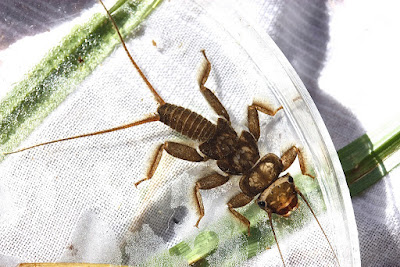It's been awhile since I've posted an entry, but it's been awhile since I found anything new. But I lucked out last week when we went to visit our daughter in Oregon. On a trip up to Mt. Hood, we stopped at a small stream in which I found some new -- for me -- insects.
Let's start with the easy one, the spiny crawler mayfly, Drunella spinifera. (In the photo above and the photo below)
As I always do when I try to ID bugs from the Northwest, I turned to the website managed by Roger Rohrbeck, PNW Mayflies (Fly Fishing Entomology). Rohrbeck describes seven different species of Drunella nymphs, and the one that works for us is Drunella spinifera. His description reads: "Femora of front legs very broad, but don't have bumps on front edge; long sharp tubercles on back of head; abdominal tubercles 8-9 more than twice as long as 2-7." Here's a look at the fore femora:
Other species of Drunella do have bumps on the front edge. E.g., in case you've forgotten, here's a look at the fore femora of Drunella cornutella, a species we find in our streams in VA.
Dramatically different. The shot I took of the tubercles on the head --
don't show the "sharpness" very well (bad angle on my part), but check out the tubercles on the abdominal segments.
The tubercles on segments 8 and 9 differ markedly from those on 2-7. No doubt about it, our nymph is Drunella spinifera. I might add that on his website "troutnut.com," Jason Neuswanger notes that this is a species that "prefers cold water," and inhabits "high elevation headwaters." We were at about 3000' ASL.
________________
Now on to the toughy.
As you can see, it was a very small stonefly nymph which makes the ID all the more difficult. However, I have reason to believe that it was Rickera sorpta. This genus and species is described on p. 440 of Stewart & Stark, Nymphs of North American Stonefly Genera. There, the head is described in the following way: "Head with dark, broad, irregular U-shaped mark connecting ocelli; light oval interocellar spot. Light area anterior to median ocellus."
On target so far. On the lacinia -- "Lacinia triangular and unidentate, with 5-6 basal marginal spinules and 2-3 medially located marginal spinules."
Unidentate for sure. I didn't note any spinules, but this was a very small, very young nymph. Now for a critical feature. "Y-arms of mesosternum meet posterior corners of furcal pits, and transverse suture connects anterior corners of furcal pits." The connecting suture is illustrated on p. 442 (Fig. 14.50), and it appears to be in the shape of a slight arc. Here's the best photo that I could manage.
I've put a rectangular box around this suture to help us focus. I'd say they're connected for sure. One other feature. Rohrbeck adds that there are "dark and light stripes on the abdomen" (PNW Stoneflies).
And there they are.
I only hesitate on my ID because there is another taxon -- Kogotus nonus -- that looks a lot light our little nymph. The head pattern's much the same, and there are dark and light stripes on the abdomen, and the lacinia is unidentate. This is one that I found a few years ago in Montana.
How do they differ? It has to do with the presence or absence of that suture connecting the furcal pits of the mesosternal Y-ridge. It's present on Rickera, absent on Kogotus. I'll stick with my ID of Rickera sorpta, for the moment at least, since I do see that suture on our small nymph.
So much fun to find something new and to work on the species ID. I should note, by the way, that I'm now posting photos on Instagram. Look for me under "buddhabob2hanlubo".






















































